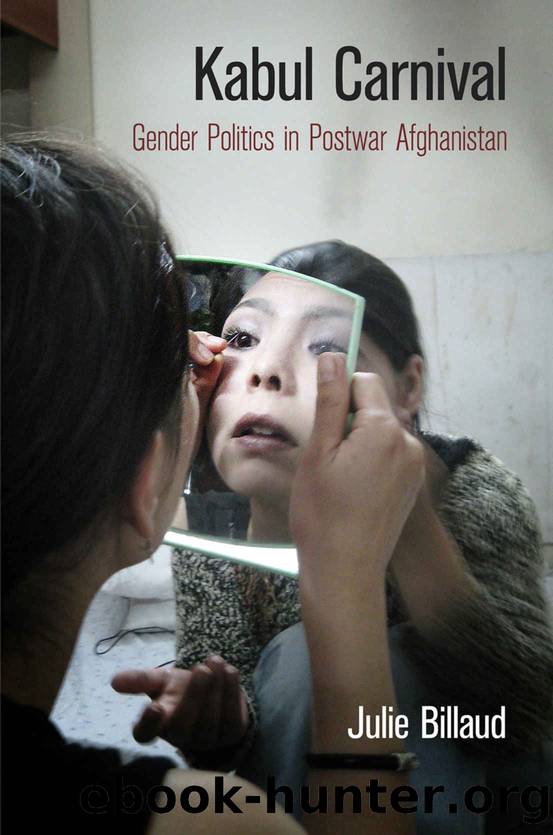Kabul Carnival (The Ethnography of Political Violence) by Billaud Julie

Author:Billaud, Julie [Billaud, Julie]
Language: eng
Format: epub
Publisher: University of Pennsylvania Press, Inc.
Published: 2015-03-08T16:00:00+00:00
The Subjective Meanings of the Soaps
TV stations, the funding agencies, and the advertising companies that support them are powerful tools to shape public opinions and promote lifestyles. âTelevision audiences are one among several sites in which local negotiations of meaning are suffused by translocal relations of knowledge and powerâ (Mankekar 1998, 32). But if television creates a global community of viewers, the same soap opera may be differently received in different parts of the world. In the dormitory, young womenâs interpretations of the soaps were located at the crossroads of these various instances of power but were also the product of their specific position within Afghan society as well as the individual experiences that had marked their lives. The soaps were conversational objects that exposed the problems inherent within the nature of the family as an institution pivotal to maintaining social stability.
For Ramzia, who had lived with her uncle in Pakistan during the war and who unlike the majority of the girls from her generation had received an uninterrupted education in the Franco-Afghan secondary school in Peshawar, the feminine models proposed in Tulsi and Perina were highly inspirational in comparison to the hopelessness that, in her opinion, marked the majority of Afghan womenâs lives. âTulsi and Perina are not Muslim but they face problems similar to those of Afghan women: unhappy marriages, difficult relationships with mothers-in-lawâ¦. The difference is that they are brave and independent. These women donât show weaknesses when they face difficulties. They are strong, independent women,â she explained. 7 Notions of independence, autonomy, and strength to which Ramzia referred were further explained in relation to a traumatic event that had occurred in her family.
Ramziaâs sister, Nafisa, had been kidnapped by a man from her village named Raouf whose marriage offers she had rejected numerous times. Raouf took Nafisa to Iran, where his family had found him a job. Nafisa disappeared for a few months until she managed to convince him to return to Afghanistan. In order to preserve her familyâs honor, Nafisa had had to marry her abductor. After she delivered her second baby, Nafisa, who was leading an unhappy life with a husband with whom she continuously argued, approached the villageâs shura (council of elders) in an attempt to obtain a divorce. The divorce was eventually granted but Nafisa was refused the custody of her children who, according to local interpretations of sharia law, belonged to her husband. The pain of being separated from her children made her rescind her decision. She stayed with Raouf and a year later gave birth to a third baby. Nafisa had turned into, in Ramziaâs words, âa prisoner in her own home.â Ramzia blamed not only Nafisaâs husband for her sisterâs unhappiness but also her grandmother who had lobbied in favor of this marriage based on the argument that the family, mostly composed of women, with an aging father at its head needed the support of another man. Unfortunately, Nafisaâs husband revealed himself to be a mediocre businessman, and Ramziaâs family never really benefited from this new connection.
Download
This site does not store any files on its server. We only index and link to content provided by other sites. Please contact the content providers to delete copyright contents if any and email us, we'll remove relevant links or contents immediately.
| Africa | Americas |
| Arctic & Antarctica | Asia |
| Australia & Oceania | Europe |
| Middle East | Russia |
| United States | World |
| Ancient Civilizations | Military |
| Historical Study & Educational Resources |
The Battle of Mogadishu by Matt Eversmann & Dan Schilling(730)
The Confidence Men by Margalit Fox(687)
The Spymaster of Baghdad by Margaret Coker(653)
A History of the Muslim World since 1260: The Making of a Global Community by Vernon O. Egger(650)
Jack the Ripper and the East End by Peter Ackroyd(622)
Empire of Fear: Inside the Islamic State by Andrew Hosken(598)
The Afghanistan File by Prince Turki AlFaisal Al Saud(595)
The Crimean War by Winfried Baumgart(590)
Islam At The Gates: How Christendom Defeated the Ottoman Turks by Diane Moczar(585)
Akhenaten by Dominic Montserrat(579)
The Jerusalem Diamond by Noah Gordon(578)
Beirut 2020 by Charif Majdalani(569)
A Concise History of Greece (Cambridge Concise Histories) by Richard Clogg(565)
The History of Jihad by Robert Spencer(562)
Israel: Ancient Kingdom or Late Invention? by Daniel I. Block(544)
Enemy in the East by Rolf-Dieter Müller(542)
The Privatization of Israeli Security by Shir Hever(536)
The Nine Lives of Pakistan by Declan WALSH(530)
Destroying a Nation: The Civil War in Syria by Nikolaos van Dam(528)
